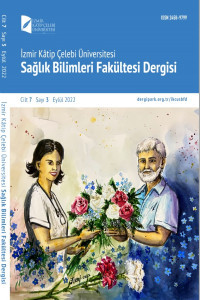Fizik Tedavi ve Rehabilitasyon Fakültesi Öğrencilerinin Teknoloji ile İlgili Bakış Açılarının Belirlenmesi
Fizyoterapi, öğrenci, rehabilitasyon, teknoloji, rehabilitasyon teknolojileri.
Determining Technology Related Perspectives of Physical Therapy and Rehabilitation Faculty Students
Physiotherapy, rehabilitation, rehabilitation technologies, student, technology.,
___
- Rehabilitation: World Health Organization; 10.11.2021 [cited 24.03.2022]. Available from: https://www.who.int/news-room/fact-sheets/detail/rehabilitation.
- Policy statement: Evidence based practice. : World Confederation for Physical Therapy; 2019 [cited 2022 24.03.2022]. Available from: https:// world.physio/policy/ps-ebp.
- What is physiotherapy?: World Confederation for Physical Therapy; [cited 24.03.2022]. Available from: https://world.physio/resources/what-is-physiotherapy.
- Kayabınar B, Kayabınar E. Nörolojik Fizyoterapi ve Rehabilitasyonda Teknolojinin Kullanımı. Nevşehir Üniversitesi; 2021.
- Swinnen E, Lefeber N, Willaert W, De Neef F, Bruyndonckx L, Spooren A, et al. Motivation, expectations, and usability of a driven gait orthosis in stroke patients and their therapists. Top Stroke Rehabil. 2017;24(4):299- 308.
- McCloy R, Stone R. Science, medicine, and the future. Virtual reality in surgery. BMJ. 2001;323(7318):912-5.
- Zabel S, Lockhart Z, Badiani N, Cornish J, Falzon L, Flis A, et al. Physiotherapy students’ perspectives on the use and implementation of exoskeletons as a rehabilitative technology in clinical settings. Disabil Rehabil Assist Technol. 2020:1-8.
- Tack C. Artificial intelligence and machine learning| applications in musculoskeletal physiotherapy. Musculoskelet Sci Pract. 2019;39:164-9.
- Aggarwal D, Ploderer B, Hoang T, Vetere F, Bradford M. Physiotherapy over a distance: The use of wearable technology for video consultations in hospital settings. ACM Trans Comput Healthc. 2020;1(4):1-29.
- Burns DM, Leung N, Hardisty M, Whyne CM, Henry P, McLachlin S. Shoulder physiotherapy exercise recognition: machine learning the inertial signals from a smartwatch. Physiol Meas. 2018;39(7):075007.
- Belas Dos Santos M, Barros de Oliveira C, Dos Santos A, Garabello Pires C, Dylewski V, Arida RM. A comparative study of conventional physiotherapy versus robot-assisted gait training associated to physiotherapy in individuals with ataxia after atroke. Behav Neurol. 2018;2018:2892065.
- Hassett L, van den Berg M, Weber H, Chagpar S, Wong S, Rabie A, et al. Activity and MObility UsiNg Technology (AMOUNT) rehabilitation trial - description of device use and physiotherapy support in the post-hospital phase. Disabil Rehabil. 2021;43(24):3454-60.
- Seron P, Oliveros MJ, Gutierrez-Arias R, Fuentes-Aspe R, Torres-Castro RC, Merino-Osorio C, et al. Effectiveness of telerehabilitation in physical therapy: a rapid overview. Phys Ther. 2021;101(6). Epub 2021/02/10.
- Erden NS. Yeni nesillere yeni öğretim yöntemleri: Z kuşağının öğrenme stilleri ve yükseköğrenim için öneriler. Javstudies. 2017;3(12):249-57.
- Shorey S, Chan V, Rajendran P, Ang E. Learning styles, preferences and needs of generation Z healthcare students: scoping review. Nurse Educ Pract. 2021;57:103247.
- Blumenthal J, Wilkinson A, Chignell M. Physiotherapists' and physiotherapy students' perspectives on the use of mobile or wearable technology in their practice. Physiother Can. 2018;70(3):251-61.
- Baltaci A. Nitel araştırmalarda örnekleme yöntemleri ve örnek hacmi sorunsalı üzerine kavramsal bir inceleme. BEÜ SBE Derg. 2018;7(1):231- 74.
- Erden A. Türkiyedeki fizyoterapi öğretim elemanlarının ve son sınıf öğrencilerinin fizyoterapi eğitimi ile ilgili memnuniyet düzeylerinin incelenmesi. 2015.
- Hacettepe Üniversitesi AKTS bilgi paketi [cited 24.03.2022]. Available from: https: //bilsis.hacettepe.edu.tr/oibs/bologna/index.aspx?lang=tr&curOp=showPac&curUnit=761&curSunit=762#.
- Sliepen M, Lipperts M, Tjur M, Mechlenburg I. Use of accelerometer-based activity monitoring in orthopaedics: benefits, impact and practical considerations. EFORT Open Rev. 2019;4(12):678-85. Epub 2020/02/06.
- Wang Q, Markopoulos P, Yu B, Chen W, Timmermans A. Interactive wearable systems for upper body rehabilitation: a systematic review. J Neuroeng Rehabil. 2017;14(1):20. Epub 2017/03/13.
- Wade SL, Narad ME, Shultz EL, Kurowski BG, Miley AE, Aguilar JM, et al. Technology-assisted rehabilitation interventions following pediatric brain injury. J Neurosurg Sci. 2018;62(2):187-202.
- Laparidou D, Curtis F, Akanuwe J, Goher K, Niroshan Siriwardena A, Kucukyilmaz A. Patient, carer, and staff perceptions of robotics in motor rehabilitation: a systematic review and qualitative meta-synthesis. J Neuroeng Rehabil. 2021;18(1):181. Epub 2021/12/27. doi: 10.1186/ s12984-021-00976-3.
- Yükseköğretim Kurulu. Fizyoterapi ve Rehabilitasyon Çekirdek Eğitim Programı FTRÇEP 2016. Ankara; 2016. Available from: https:// www.yok.gov.tr/Documents/Kurumsal/egitim_ogretim_dairesi/Ulusal-cekirdek-egitimi-programlari/fizyotreapi_cekirdek_egitim_programi. pdf.
- ISSN: 2458-9799
- Yayın Aralığı: Yılda 3 Sayı
- Başlangıç: 2016
- Yayıncı: İzmir Katip Çelebi Üniversitesi
Sevtap GÜNAY UÇURUM, Damla KARABAY, Hilal UZUNLAR, Derya ÖZER KAYA, Berna EROĞLU FİLİBELİ, Bumin DÜNDAR
Sağlık Bilimleri Öğrencilerinin Alzheimer Hastalığı ve Demansa Yönelik Bilgi ve Tutumları
Sağlık Okuryazarlığının Kadın Sağlığı Üzerine Etkileri: Bir Sistematik Derleme
Sabriye UÇAN YAMAÇ, Nurten TERKEŞ
Yeliz DOĞAN MERİH, Ayşegül ALİOĞULLARI
Presenteeism: Hemşirelik Bakım Davranışlarını Etkileyen Bir Faktör
Özlem KARDAŞ KİN, Ayşegül ÇELİK
Çalışma Yaşamında Dezavantajlı Gruplar ve Eşitsizlikler
Gelişimsel Bakış Açısıyla Spinal Musküler Atrofi’de Çocuğun Sağlık Hakkı ve Yaşam Kalitesi
Senemhan YILMAZ, Bedriye Tuğba KARAASLAN, Gözde AKOĞLU
Kanserli Çocukların Kardeşlerinde Depresyonun Değerlendirilmesi: Bir Pilot Çalışma
İbrahim EKER, Özge VURAL, Hamide Nur ÇEVİK ÖZDEMİR, Elif Bilge KELEBEK, Nihan ÇAKALOĞULLARI, Naci GÜLTEKİN, Özge KAYA, Esma KURAL, Bilge MUMYAKMAZ, Orçun ÖZTÜRK, Nevzat SAKARYA
